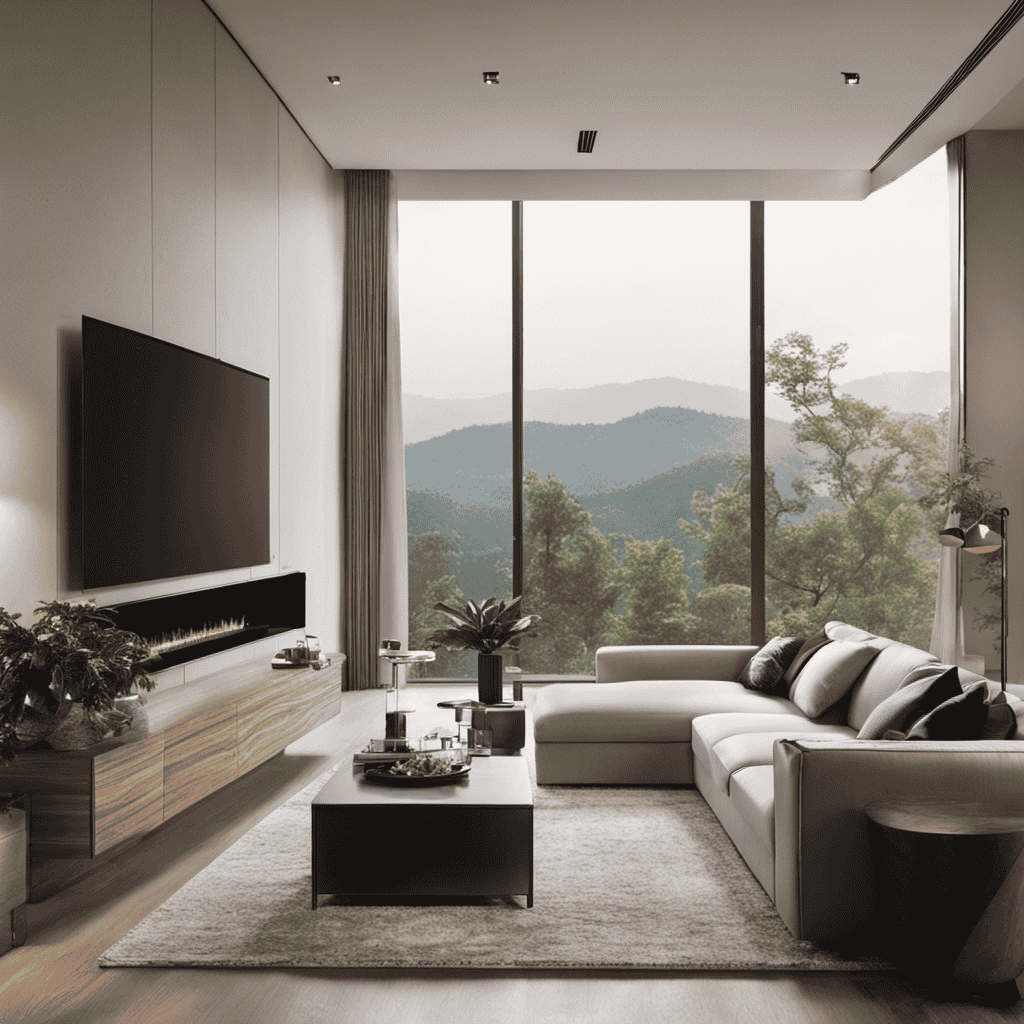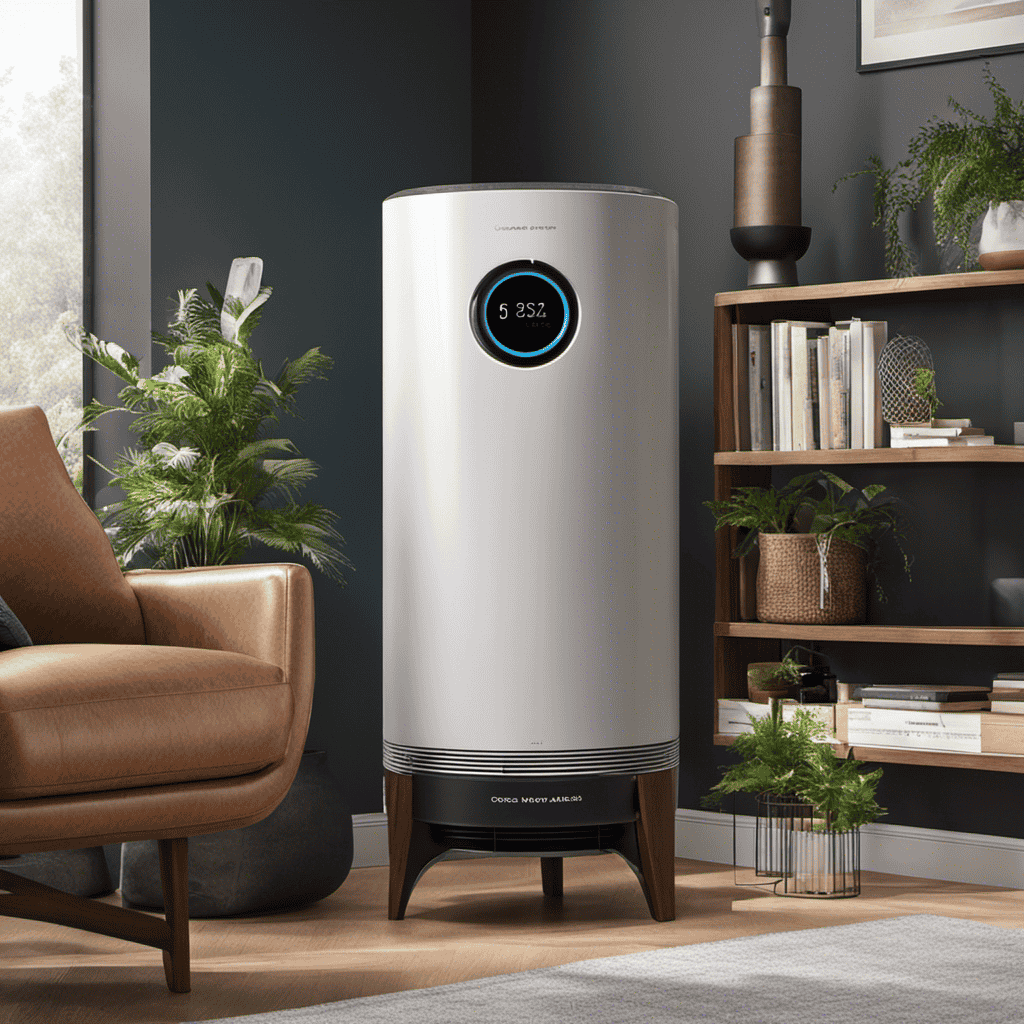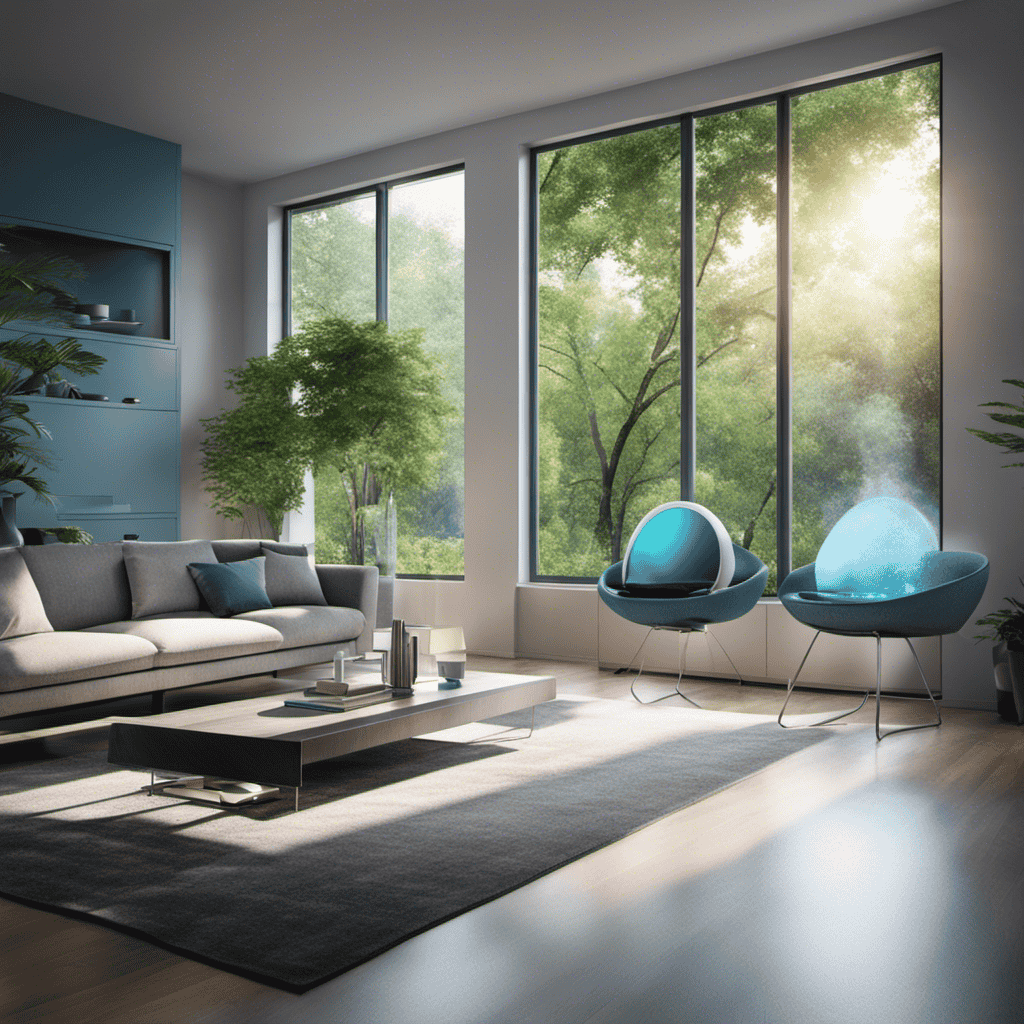I have always been curious about the optimal location to place an air purifier in my living room. Having clean and fresh air is a priority for me, so I want to ensure that I am getting the most out of its effectiveness.
After doing some research, I’ve discovered some key factors to consider when choosing the right placement for your air purifier.
In this article, I’ll share with you the ideal placement options, the benefits of placing it near windows, and why you should avoid heat sources.
Let’s dive into the details and find the perfect spot for your air purifier.
Key Takeaways
- Placing the air purifier near windows or doors allows better air circulation and captures airborne particles.
- Keep the air purifier away from furniture to avoid obstruction of airflow.
- Avoid placing the air purifier in corners or against walls for optimal effectiveness in filtering out pollutants.
- Regularly reevaluate and adjust the placement of your air purifier to maintain optimal air quality and ensure effective purification.
Understanding the Importance of Air Purifiers in Living Rooms
You should know that air purifiers are essential for improving the air quality in your living room.
When it comes to optimal positioning, there are a few key factors to consider.
First, place the air purifier in an area with good airflow, away from walls or furniture that could obstruct the air intake or output. This will ensure efficient circulation throughout the room.
Secondly, consider placing the purifier near potential sources of pollutants, such as smoking areas or pet zones. By doing so, you can effectively capture and remove these contaminants from the air.
Lastly, aim to position the purifier in a central location within the living room, allowing it to cover a larger area and provide the most comprehensive air purification.
Factors to Consider When Choosing the Right Placement for Your Air Purifier
When it comes to choosing the right placement for your air purifier, two key factors to consider are optimal air circulation and minimizing obstruction risks.
Optimal air circulation ensures that the purified air is effectively distributed throughout the room, maximizing its efficiency in removing pollutants.
Minimizing obstruction risks involves placing the air purifier away from objects or furniture that could block its intake or output, allowing for unrestricted airflow.
Optimal Air Circulation
For optimal air circulation, it’s best to place the air purifier in a central location in the living room. This strategic positioning allows the purifier to efficiently improve airflow throughout the entire space.
Here are three reasons why this placement is beneficial:
-
Enhanced Coverage: Placing the air purifier in the center of the room ensures that it can effectively reach all corners and areas, maximizing its coverage. This helps to eliminate pollutants and allergens from every part of the living room.
-
Balanced Air Distribution: The central location helps in evenly distributing purified air throughout the entire room. This prevents any stagnant areas and ensures that every occupant can enjoy clean and fresh air, regardless of their position in the living room.
-
Optimal Filtration Efficiency: By positioning the air purifier centrally, it can draw in and filter air from all directions. This allows it to capture a higher volume of pollutants and allergens, improving the overall air quality in the living room.
Minimize Obstruction Risks
To minimize obstruction risks, it’s important to position the air purifier in a location that allows for unobstructed airflow. This will enhance the efficiency of the air purifier and ensure that it effectively cleans the air in your living room. Here are some key considerations to keep in mind when deciding where to place your air purifier:
-
Distance from walls: Place the air purifier at least a few inches away from walls to allow for proper air circulation.
-
Height placement: Position the air purifier at a height that is level with your breathing zone, typically around chest or head level.
-
Avoiding furniture: Avoid placing the air purifier behind or underneath furniture, as this can block the airflow and reduce its effectiveness.
Ideal Placement Options for Maximum Air Purification
When it comes to placing an air purifier for maximum air purification, there are a few key points to consider.
Firstly, positioning the purifier near windows or doors allows for better air circulation and helps in capturing airborne particles that enter from outside.
Secondly, it is important to keep the purifier away from furniture as it can obstruct the airflow and reduce its effectiveness.
Lastly, avoiding corners or walls is recommended as it allows for better distribution of clean air throughout the room.
Near Windows or Doors
Placing the air purifier near windows or doors can help filter out pollutants coming from outside. This strategic placement allows the purifier to capture and remove airborne particles that may enter your living space through these openings. Here are three reasons why window and door placement is beneficial for air purification:
-
Incoming pollutants: Windows and doors are common entry points for outdoor pollutants such as pollen, dust, and smoke. By positioning the air purifier nearby, it can effectively capture these particles before they have a chance to spread throughout the room.
-
Improved airflow: Placing the purifier near windows or doors allows it to take advantage of natural airflow. As fresh air enters through these openings, the purifier can efficiently circulate and filter it, ensuring a constant supply of clean air in the room.
-
Odor elimination: If you have unpleasant odors coming from outside, positioning the purifier near windows or doors can help eliminate them. The purifier’s activated carbon filter can effectively trap and neutralize odorous particles, leaving your living room smelling fresh and clean.
Away From Furniture
Positioning your air purifier away from furniture allows for better airflow and ensures that it can effectively filter out pollutants in the room.
When it comes to placing your air purifier in the living room, it is important to consider its placement near windows and to avoid heat sources.
Placing the air purifier near windows can help in capturing outdoor pollutants, such as pollen or dust, that may enter through open windows.
Additionally, keeping the air purifier away from heat sources, such as radiators or direct sunlight, is crucial to prevent any damage to the device and to maintain its optimal performance.
Avoid Corners or Walls
Avoid placing your air purifier in corners or against walls to ensure optimal airflow and maximum effectiveness in filtering out pollutants. When it comes to purifier placement, here are three key factors to consider:
-
Ideal Height: It is important to position your air purifier at the right height. Placing it too high or too low can hinder its efficiency. The ideal height is typically at the same level as your breathing zone, which is around 3 to 6 feet off the ground. This ensures that the purifier effectively captures the pollutants present in the air you breathe.
-
Distance from Obstructions: Keep your air purifier at least a foot away from walls, furniture, or any other obstructions. This allows for better air circulation and prevents the purifier from being blocked or restricted in any way. Avoiding obstructions ensures that the purifier can draw in air from all directions and effectively filter out pollutants.
-
Central Location: Place your air purifier in a central location within the room. This allows for better distribution of clean air throughout the space. Avoid placing it in corners or near walls, as this can limit the purifier’s ability to effectively circulate and purify the air in the entire room.
The Benefits of Placing an Air Purifier Near Windows
Having an air purifier near windows can provide numerous benefits for improving indoor air quality. The effectiveness of placing an air purifier near windows lies in its ability to capture and filter outdoor pollutants before they enter the room.
Windows are often a major source of outdoor air pollutants such as dust, pollen, and smoke particles. By positioning the air purifier near windows, it can effectively capture these pollutants, preventing them from circulating in the room and compromising indoor air quality.
Additionally, having an air purifier near windows allows for better air circulation and ventilation, as it can draw in fresh air from outside while simultaneously purifying it. This not only helps in removing indoor pollutants but also provides a continuous flow of clean air, promoting a healthier living environment.
Why You Should Avoid Placing Your Air Purifier Near Heat Sources
If you want your air purifier to work effectively, it’s best to keep it away from heat sources like radiators or heaters. Placing your air purifier near heat sources can actually reduce its effectiveness and pose potential dangers.
Here are three reasons why you should avoid placing your air purifier near heat sources:
-
Temperature Sensitivity: Air purifiers are designed to work optimally within a specific temperature range. Exposing them to excessive heat can cause their internal components to overheat, leading to reduced performance and potential malfunctions.
-
Air Circulation: Heat sources generate warm air currents, which can interfere with the air purifier’s ability to effectively circulate and filter the room air. This can result in poor air purification and reduced air quality.
-
Fire Hazard: Heat sources like radiators or heaters can be potential fire hazards. Placing your air purifier too close to these heat sources increases the risk of overheating and potentially causing a fire.
How to Determine the Best Location for Your Air Purifier Based on Room Layout
When it comes to optimizing the placement of your air purifier, considering the room’s traffic flow is crucial. By strategically placing your purifier in an area with high foot traffic, you can ensure that the air is constantly being cleaned and circulated efficiently.
This allows for a more effective removal of pollutants and allergens, resulting in improved air quality throughout the room.
Optimal Air Purifier Placement
The best spot for an air purifier in the living room is near a window. This strategic placement allows for efficient air circulation and ensures that the purifier is able to capture and filter out pollutants effectively. Here are three reasons why this location is optimal for air purification efficiency:
-
Fresh air intake: Placing the air purifier near a window allows it to draw in fresh outdoor air, which can help improve indoor air quality. This is especially beneficial if you live in an area with clean outdoor air or have access to a garden or green space.
-
Dust and pollen capture: Windows are common entry points for dust and pollen particles. By positioning the air purifier near a window, you increase its chances of capturing these allergens and preventing them from circulating in your living room.
-
Ventilation support: Air purifiers often come with built-in fans that help circulate the purified air. Placing the purifier near a window allows it to work in conjunction with natural ventilation, facilitating better airflow and distribution of clean air throughout the room.
Consider Room Traffic Flow
Consider positioning the air purifier in an area of high traffic flow, such as near the entrance or hallway, to ensure that the purified air reaches all corners of the room. This strategic placement is crucial for maximizing the effectiveness of the air purifier and optimizing airflow within the living room.
By placing the air purifier in a high traffic area, you can take advantage of the natural air currents created by people moving in and out of the room. This will help to circulate the purified air throughout the space, ensuring that every corner receives the benefits of clean and fresh air.
Additionally, placing the air purifier near the entrance or hallway can help to capture pollutants and allergens before they have a chance to spread throughout the room, further enhancing the air purification process.
The Impact of Furniture and Obstacles on Air Purifier Effectiveness
Placing furniture and obstacles near the air purifier can hinder its effectiveness. Here are three reasons why furniture placement and obstructed airflow can impact the performance of your air purifier:
-
Restricted Airflow: When furniture is placed too close to the air purifier, it can obstruct the airflow, preventing the purifier from effectively circulating and cleaning the air in the room. This can lead to reduced air purification and lower overall indoor air quality.
-
Blocked Intake and Exhaust: Furniture positioned in front of the air purifier’s intake or exhaust vents can block the flow of air, making it difficult for the purifier to draw in and expel air properly. This can result in reduced efficiency and compromised performance.
-
Interference with Sensors: Some air purifiers have sensors that detect air quality levels and adjust the purification settings accordingly. Placing furniture near these sensors can obstruct their function, leading to inaccurate readings and improper air purification.
To ensure optimal performance, it is important to keep furniture and obstacles away from the air purifier, allowing for unrestricted airflow and proper operation.
Placing an Air Purifier at the Right Height for Optimal Air Circulation
When it comes to optimizing air circulation with an air purifier, placement is key. Finding the optimal location in a room can greatly improve the effectiveness of the purifier in filtering and circulating the air.
Additionally, considering the ideal height for the purifier is crucial in order to ensure that it can capture and filter airborne pollutants effectively.
Lastly, improving air flow around the purifier can be achieved by strategically placing it away from obstacles and ensuring that there is proper ventilation in the room.
Optimal Placement for Circulation
To ensure proper circulation, place the air purifier in a central location in your living room. This will help improve air circulation throughout the entire space. Here are three key points to consider when placing your air purifier:
-
Avoid obstructing airflow: Make sure to keep your air purifier away from walls, furniture, or any other objects that could block the airflow. This will allow the purifier to effectively capture and filter the air in your living room.
-
Consider the size of the room: If you have a large living room, you may need to position the air purifier closer to where you spend the most time. This will ensure that the air in that area is constantly purified.
-
Place the purifier at an appropriate height: The ideal height for an air purifier is usually around chest level. This allows the purifier to effectively capture airborne particles without being obstructed by furniture or other objects.
Ideal Height for Purifier
When it comes to placing an air purifier in your living room, finding the ideal height is crucial for optimal performance. The position of the purifier plays a significant role in ensuring efficient air circulation and purification throughout the room.
To determine the optimal height for your air purifier, consider the following factors:
| Height Level | Advantages | Disadvantages |
|---|---|---|
| Low | – Easy to access for maintenance – Suitable for small rooms |
– Limited coverage – Reduced air circulation |
| Mid | – Provides moderate coverage – Allows for better air circulation |
– May obstruct views – Requires regular cleaning |
| High | – Maximum coverage – Enhanced air circulation |
– Difficult to clean and maintain – May cause noise disruption |
Improving Air Flow
Improving air flow is essential for maximizing the efficiency of your air purifier. By increasing air circulation and optimizing airflow, you can ensure that your purifier is working at its best. Here are three ways you can improve air flow in your living room:
-
Position the purifier strategically: Place your air purifier in an area where it can draw in the most air, such as near a window or in the center of the room. Avoid obstructing the intake and output vents to allow for unrestricted air flow.
-
Use a fan: Placing a fan near your air purifier can help to circulate air more effectively. The fan will help to push air towards the purifier and distribute purified air throughout the room.
-
Clean and replace filters regularly: Dirty or clogged filters can hinder air flow and reduce the effectiveness of your air purifier. Make sure to clean or replace the filters as recommended by the manufacturer to ensure optimal performance.
The Importance of Avoiding Corners When Positioning Your Air Purifier
Avoid placing your air purifier in corners as it can limit its effectiveness. When positioning your air purifier, it is important to consider the benefits of central placement.
Placing the air purifier in the center of the room allows for better air circulation and distribution throughout the space. By avoiding corners, you ensure that the purifier can capture pollutants from all directions and effectively clean the air in the room.
Corners can obstruct the airflow and create stagnant areas where the air purifier may struggle to reach. Central placement also allows the air purifier to cover a larger area, maximizing its efficiency.
Why You Should Consider Placing an Air Purifier in the Center of the Living Room
You should consider positioning your air purifier in the center of your living room for optimal air circulation and distribution. Placing the air purifier in the center allows it to effectively remove pollutants from all corners of the room, ensuring cleaner and fresher air throughout.
Here are the reasons why this placement is beneficial:
-
Enhanced air circulation: By placing the air purifier in the center, it can draw in air from all directions, creating a more efficient flow of air. This helps in capturing airborne particles and circulating clean air throughout the room.
-
Balanced distribution: Placing the air purifier in the center ensures equal distribution of purified air in all areas of the living room. This helps in maintaining consistent air quality and reducing the concentration of pollutants in specific spots.
-
Easy maintenance: Positioning the air purifier in the center makes it easily accessible for regular maintenance. It allows you to clean or replace filters conveniently, ensuring the device operates at its best and prolonging its lifespan.
Overall, placing your air purifier in the center of your living room maximizes its effectiveness, providing you with cleaner and healthier indoor air.
The Benefits of Placing an Air Purifier Near High-Traffic Areas
Positioning your air purifier near high-traffic areas ensures that it effectively captures and removes pollutants brought in by constant movement.
There are several benefits to placing your air purifier in these areas.
Firstly, high-traffic areas like hallways and entryways are the main pathways for pollutants to enter your home. By placing the air purifier in these areas, you can intercept and eliminate these pollutants before they spread throughout your living space.
Secondly, placing the air purifier near high-traffic areas increases its efficiency in capturing and removing airborne particles. As people move around, they can stir up dust, dirt, and allergens, which can then be easily trapped by the air purifier.
Lastly, positioning the air purifier in high-traffic areas ensures that it continuously cleans the air, providing you with clean and fresh indoor air quality.
How to Strategically Position Your Air Purifier to Target Specific Problem Areas
For optimal results, it’s important to strategically position your air purifier in order to target specific problem areas in your home. Here are three key considerations when it comes to room layout and furniture placement:
-
Identify problem areas: Take note of where the sources of pollutants are in your living room. Is it near the kitchen, where cooking odors and smoke may be an issue? Or is it closer to the entrance, where dust and outdoor pollutants may enter? Understanding the problem areas will help you determine the best placement for your air purifier.
-
Maximize airflow: Ensure that your air purifier has enough space around it to allow for proper airflow. Avoid placing it in corners or behind large furniture that may obstruct the air circulation. Instead, position it in a central location where it can effectively capture and filter the air in the room.
-
Consider furniture placement: Take into account the placement of your furniture when positioning your air purifier. Avoid blocking the airflow by keeping furniture away from the air purifier’s inlet and outlet vents. Additionally, if you have large furniture pieces such as sofas or bookcases, try to position them in a way that does not create an obstacle between the air purifier and the problem areas.
The Impact of Ceiling Fans and Vents on Air Purifier Placement
Ceiling fans and vents can affect where you should position your air purifier. When it comes to air purifier placement, it’s essential to consider the potential interference caused by ceiling fans and the obstruction caused by vents.
Ceiling fans can disrupt the flow of air, making it challenging for the purifier to effectively circulate and filter the air in the room. To minimize this interference, it’s advisable to position the air purifier away from the direct airflow of the fan.
Vents, on the other hand, can obstruct the airflow and limit the purifier’s efficiency. It’s crucial to ensure that the vents are not blocked by the air purifier, allowing unrestricted airflow.
Tips for Placing Multiple Air Purifiers in Larger Living Rooms
Now that we’ve discussed the impact of ceiling fans and vents on air purifier placement, let’s delve into some tips for placing multiple air purifiers in larger living rooms.
When it comes to maximizing air purification in a spacious area, here are three key considerations:
-
Strategic Placement: To ensure optimal air circulation, it’s important to position the air purifiers at different corners of the room. This will create a crossflow effect and help cover a wider area.
-
Proper Spacing: Keep a distance of at least six feet between each air purifier. This will prevent any interference between their airflow and allow them to effectively filter the air in their designated zones.
-
Synchronized Settings: If your air purifiers have adjustable fan speeds, try to synchronize them at the same level. This will help maintain consistent air quality throughout the room and prevent one purifier from overpowering the others.
The Importance of Regularly Reevaluating and Adjusting the Placement of Your Air Purifier
It’s crucial to regularly reassess and adjust where you position your air purifier in order to maintain optimal air quality. Reevaluating the placement of your air purifier allows you to identify any changes in your living room’s airflow patterns and make necessary adjustments to ensure effective purification. By reassessing placement, you can target specific areas in your living room that may require more purification, such as near windows or high-traffic areas. Adjusting airflow is also important as it allows you to direct the purified air towards areas where you spend the most time. To help you with this process, here is a table outlining different factors to consider when reassessing and adjusting the placement of your air purifier:
| Factors to Consider | Importance |
|---|---|
| Airflow patterns | High |
| Proximity to windows | Medium |
| Proximity to doors | Medium |
| High-traffic areas | High |
| Proximity to furniture | Low |
Regularly reassessing and adjusting the placement of your air purifier will ensure that you are maximizing its effectiveness in maintaining clean and healthy air in your living room.
Frequently Asked Questions
Can I Place My Air Purifier on the Floor or Does It Need to Be Elevated?
I can place my air purifier on the floor or elevate it. Placing it on the floor is fine as long as there is enough space around it for proper air circulation and it is not obstructed.
Is It Necessary to Place an Air Purifier Near Windows for Maximum Effectiveness?
Placing an air purifier near windows can enhance its effectiveness by reducing outdoor pollutants. Additionally, positioning it near plants can provide the benefits of natural air purification. These strategic placements optimize the air quality in your living room.
Can I Place My Air Purifier Near a Fireplace or Other Heat Sources?
Placing an air purifier near a fireplace or other heat sources can impact its effectiveness. The heat can cause the purifier to overheat or affect its filtration capabilities. It’s best to keep the purifier away from direct heat sources for optimal performance.
How Do Furniture and Obstacles Affect the Effectiveness of an Air Purifier?
Furniture placement and obstacles can significantly impact the effectiveness of an air purifier. When obstructed, airflow is restricted, reducing the purifier’s ability to circulate and clean the air in the room.
Should I Avoid Placing My Air Purifier in Corners of the Living Room?
Avoid placing the air purifier in corners of the living room as it may restrict airflow and reduce effectiveness. Consider placing it at a height that allows for optimal air circulation throughout the room.
Conclusion
In conclusion, placing an air purifier in the right location is crucial for maximum effectiveness in purifying the air in your living room.
By considering factors such as proximity to windows and heat sources, strategically positioning the purifier, and reevaluating its placement periodically, you can optimize its performance.
Remember, ‘out with the old, in with the new’ – regularly reevaluating and adjusting the placement of your air purifier will ensure that you are always breathing in fresh, clean air.
So don’t hesitate, take control of your indoor air quality today!










